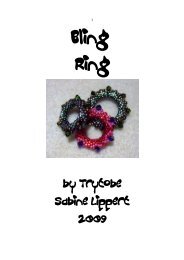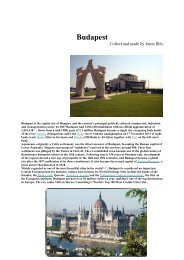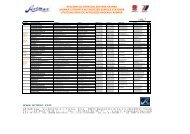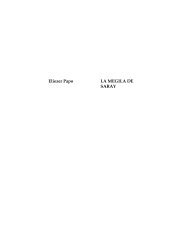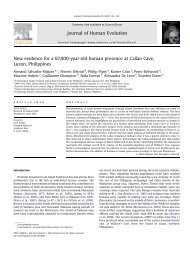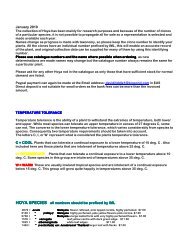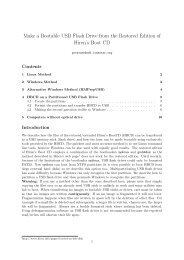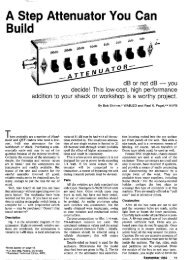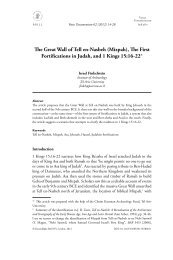ARTICLE IN PRESS Journal of Human Evolution
ARTICLE IN PRESS Journal of Human Evolution
ARTICLE IN PRESS Journal of Human Evolution
You also want an ePaper? Increase the reach of your titles
YUMPU automatically turns print PDFs into web optimized ePapers that Google loves.
2<br />
<strong>ARTICLE</strong> <strong>IN</strong> <strong>PRESS</strong><br />
Jordan Rift (Fig. 1). The archaeological layers <strong>of</strong> the ‘Ubeidiya<br />
Formation have been systematically excavated since 1960 (Stekelis,<br />
1966a,b; Stekelis et al., 1969; Bar-Yosef and Goren-Inbar, 1993)<br />
through the late 1990s (Stekelis,1966a; Stekelis et al.,1969; Bar-Yosef<br />
and Goren-Inbar, 1993; Guérin et al., 1996,2003; Shea and Bar-Yosef,<br />
1998), and are known for rich faunal (Haas, 1966,1968; Tchernov,<br />
1986; Belmaker, 2006) and lithic assemblages (Bar-Yosef and Goren-<br />
Inbar, 1993; Shea and Bar-Yosef, 1998). The primate assemblage<br />
includes dental and postcranial material <strong>of</strong> Macaca sylvanus (Tchernov<br />
and Volokita,1986) as well as a small sample <strong>of</strong> Homo cf. ergaster/<br />
erectus dental material (Tobias, 1966a,b; Belmaker et al., 2002).<br />
Estimated dates for the fossil-bearing strata <strong>of</strong> the ‘Ubeidiya<br />
Formation are between ca. 1.6–1.2 Ma. Paleomagnetic analysis <strong>of</strong><br />
the ‘Ubeidiya Formation indicate that it overlies the ‘Erq el Ahmar<br />
Formation, which is dated at 1.96–1.78 Ma (Ron and Levi, 2001) and<br />
has a reversed polarity, suggesting that it predates the Brunhes–<br />
Matuyama reversal (Opdyke et al., 1983; Braun et al., 1991; Verosub<br />
and Tchernov, 1991). Two short, normal paleomagnetic episodes<br />
M. Belmaker / <strong>Journal</strong> <strong>of</strong> <strong>Human</strong> <strong>Evolution</strong> xxx (2009) 1–11<br />
Figure 1. Location <strong>of</strong> the site <strong>of</strong> ‘Ubeidiya in the Southern Levant.<br />
have been found in strata II 33 and II 23–24 in the Fi member and<br />
have been assigned to the Cobb Mt. (1.215–1.190 Ma) and the Gilsa<br />
(1.575–1.567 Ma), respectively (Sagi, 2005). The dating <strong>of</strong> these<br />
short polarity events is corroborated by local faunal turnovers. The<br />
‘Ubeidiya fauna can be assigned to a local mammalian fauna biozone<br />
older than that in the sites <strong>of</strong> Bitzat Ruhama, Evron, and<br />
Latamne dated to ca. 1.0–1.2 Ma, suggesting that the ‘Ubeidiya<br />
normal polarity events in strata II 23-24 and II 33 should both<br />
predate the Jaramillo (0.99–1.07 Ma). (For a detailed stratigraphic<br />
correlation, see Supplementary Online Material Figure S1) (Belmaker,<br />
2009). Furthermore, the large mammalian assemblage <strong>of</strong><br />
‘Ubeidiya is similar to the Farneta faunal unit (the sites <strong>of</strong> Selvella<br />
and Pietrafitta, Italy) (Belmaker, 2006; Martínez-Navarro et al.,<br />
2009), which has been dated to ca. 1.6–1.2 Ma (Caloi and Palombo,<br />
1997, and references therein), and the lithic assemblage is similar to<br />
those from East African sites (Stekelis et al., 1969; Bar-Yosef and<br />
Goren-Inbar, 1993) such as Olduvai Upper Bed II, dated to ca. 1.53–<br />
1.27 Ma (Gowlett, 1979; Cerling and Hay, 1986).<br />
Please cite this article in press as: Belmaker, M., The presence <strong>of</strong> a large cercopithecine (cf. Theropithecus sp.) in..., J Hum Evol (2009), doi:10.1016/<br />
j.jhevol.2009.08.004



